Neil Peart's News, Weather and Sports
Shunpikin' it Old Skool
NeilPeart.net, September 2007
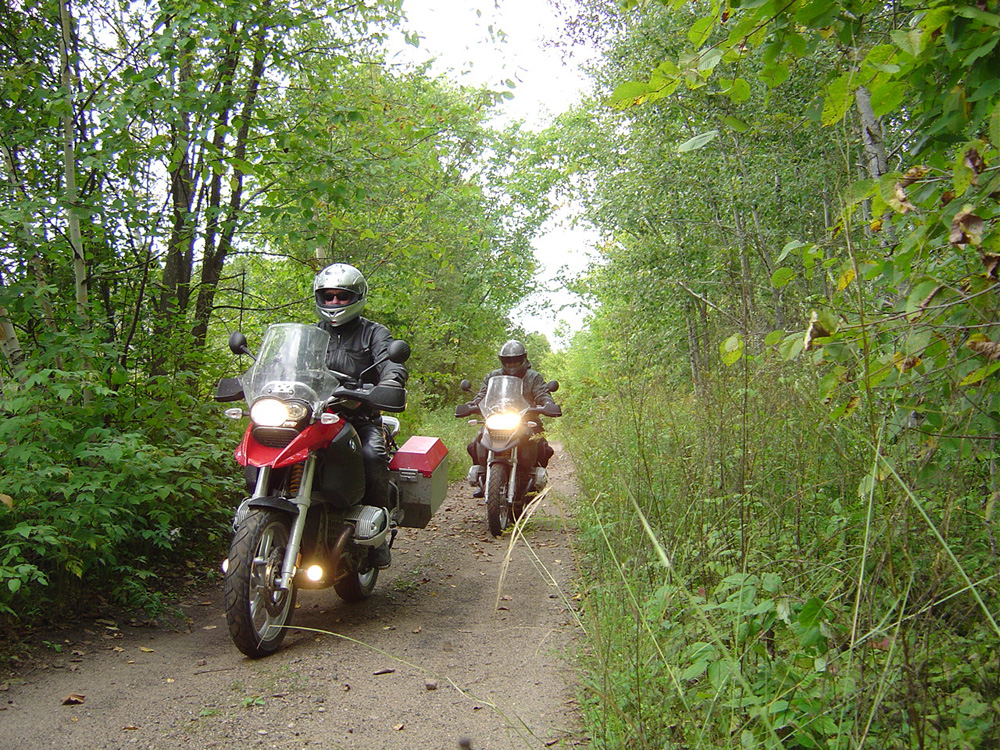
That phrase appears on the back of a T-shirt Michael and I are designing for our two-man "biker gang," the West Side Beemer Boyz, to share among our coworkers on the Snakes and Arrows tour. I had run across the term "shunpiking" in car and motorcycle magazines a few times, and thought it was fairly well known, but apparently many people are unfamiliar with the concept.
It goes back about 500 years, to a time when British roads were lawless, especially at night, prowled by highwaymen and footpads. Villages blockaded their entry roads with a long pole - a pike - stretched across them. Around the same time, toll roads were invented, and a similar pike blocked the way until travelers paid their fee, when the pike would be turned - hence "turnpike."
In those days, travelers who deliberately avoided toll roads called themselves "shunpikers." Lately, the term has been adopted by drivers and riders who deliberately avoid all major roads. On the Snakes and Arrows tour, as Michael and I have commuted to forty-nine shows and covered just under 20,000 motorcycle miles around the U.S. and Canada, we have become major shunpikers.
One night on the bus after a show, while Dave drove us to yet another truck-stop dropoff point, Michael and I were talking about our recent travels. We agreed that less than ten percent of those 20,000 miles had been traveled on interstates and freeways - or divided four-lanes or major secondaries, for that matter (I dislike those the most; they are slow, congested, and unpretty). Nearly all of those miles had been traveled on the smallest roads, through the smallest settlements.
Because we ride BMW GS bikes, the so-called "adventure touring" model, we feel obliged to ride some unpaved roads pretty much every day, just on principle. Given the present sophistication and adaptability of our GPS systems on the bikes, and our growing skill in using them, I have been tracing out routes over the very thinnest lines on the Rand McNally maps. In the afternoon before sound check, I spread the next day's state, or states, across the floor of the bus's front lounge and highlight a route.
In between Michael's errands on his security duties, and getting the bikes loaded and tied down in the trailer, he sits on the floor in front of his computer and traces my zigzags onto the software maps, then downloads the route to our bike-mounted units, Doofus II and Dingus II (who, as previously noted, are much smarter than their predecessors, but still occasionally earn their nicknames).
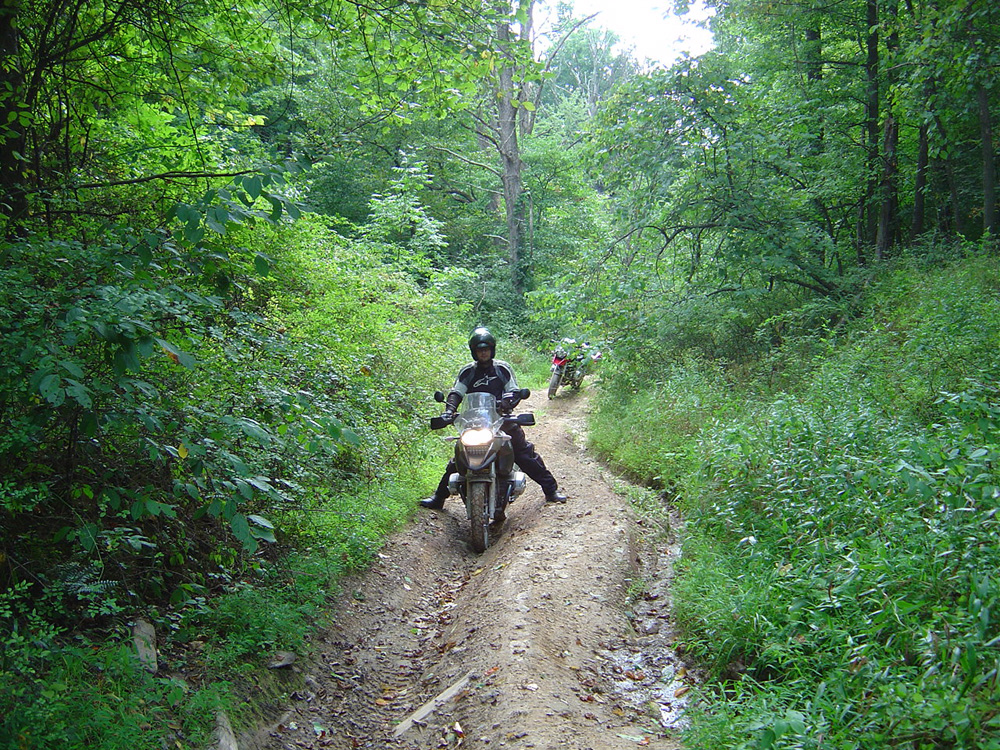
Like here. It looks like the Amazon rainforest, but it was a "road" in West Virginia - a road, it must be noted, that was indicated on the Rand McNally map, and on the GPS software.
We were somewhere near a dot on the map with the unlikely name of Volcano, West Virginia. After several miles of graded gravel through deep woods and occasional subsistence farms, the road had narrowed to a pair of gravel tracks with grass between them, then deteriorated to this abandoned old logging road. It might have been untended for fifty or a hundred years, and was apparently only used by hunters in deer season. Their high-clearance 4x4s had dredged deep ruts through mud, rocks, and roots, and we made at least twenty water crossings, the muddy surface a hazard impossible to guess until we plunged through it in a fountain of brown spray.
Michael later described the experience of trying to navigate our heavy, bucking motorcycles over that territory as "riding the bull," and that's as good a metaphor as any. When I took this photo of Michael standing astride his bike in a knee-deep rut, I had just called a halt and stopped behind him. I said I would walk up the hill ahead of us, to see if it got any worse.
I reported that it still looked bad, but perhaps not any worse. For myself, I was not keen to try to turn our bikes around in that spot, nor was I eager to ride back down over the same torturous way we had come. I hoped that going forward would bring us out ... somewhere.
Michael agreed, and we carried on riding the bull through another mile or so, until we emerged from the woods at what looked like Jed Clampett's farm, and breathed easier to find ourselves back on "solid gravel" again.
Wanting to reach Gallipolis, Ohio, that night (because I had stayed there back in '96 one time, with Brutus, and always liked the name - though it took me ages to learn to pronounce it correctly, like "gallipolice" - and because Michael hoped to meet his old friends Lance and Angie there), we set Doofus and Dingus for "Quickest Way." Even then, we had to ride at least another ten miles of gravel roads to get out of that shunpiker's maze.
Now might be a good time to explain why this Web site's book review department, "Bubba's Book Club," has been growing cobwebs over there. Lately my life has allowed little time for reading, immersed as I have been in a world centered on my motorcycle and my drums. The brief snatches of reading time before sleep on the bus or some backwater motel are of little substance outside my own current paradigm - Motorcyclist, Cycle World, Cycle Canada, Rider, BMW Owners News, and like that. When you spend most of your daytime hours in the saddle of a motorcycle, no subject is of more urgent interest than motorcycling adventures, roadcraft and safety advice, equipment, and accessories. Fine to read about, but not so much to write about.
With two exceptions. Early in the tour, a fan in Florida sent me a hardcover edition of Ernest Hemingway's stories he had purchased at the Hemingway museum in Key West, including a nice laminated bookmark (the giver signed his note, with reference to my comments about Florida in Roadshow, "from one of the 'friendly' Floridians"). Late at night while the bus roared down the interstate, or finally came to rest in a truck stop (I love that moment when the main engine dies into the hum of the generator, and I know my bed is not going to move anymore), I started to read a few of those wonderful stories, fresh again after so many readings. With writing of such depth and craft, it is true that you can never read the same book twice.
And as so often happens, by accident or design, art and life intersected. After a show in Indianapolis, with a day off before Detroit, Dave parked us in northern Indiana. In the morning Michael and I unloaded the bikes and headed as far north into Michigan as we could get (on the very smallest roads, of course, shunpikin' it old school).
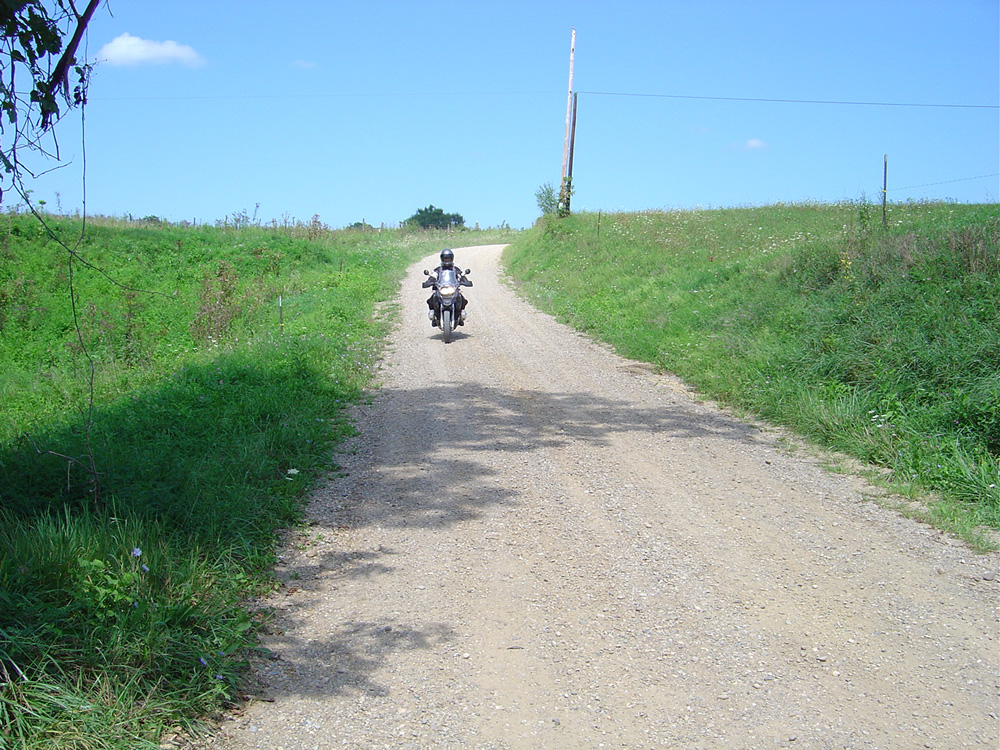
I had always presumed such Hemingway stories as "Up in Michigan," "Three Day Blow," and "Big Two-Hearted River" were set in the Upper Peninsula of Michigan. Because I didn't recognize the towns he named from my travels in that area, I thought they were fictionalized. But when Michael and I got to the northern tip of Lake Michigan, up near Mackinaw City, I recognized signs for Hortons Bay, Boyne City, and Charlevoix (where Michael and I spent the night. They pronounce it "sharlevoy," not "sharlevwah," like we Canadians would) - and realized that this was Hemingway's Michigan.
The other two books I read this tour were both by Wallace Stegner, bought at the national park visitor center (always great book shopping) at Great Basin National Park, in Nevada, near the Utah border. One was The Gathering of Zion, about the Mormon trek from Illinois to the Great Salt Lake (about which more later), and the other was Marking the Sparrow's Fall: The Making of the American West.
Again, art and life synchronized. I was reading that book at the same time Michael and I were riding the rural routes of the heartland, the corn and soybean country of Missouri, Illinois, Indiana, and Ohio. (After a few thousand miles of that, I said to Michael one day, "Corn and soybean fields are pretty and everything, but I really don't mind if I never see another one.") Apparently all of those crops are destined for animal feed, which would tend to support a theory I heard recently that the greatest cause of global warming is actually the meat industry. (As a wise journalist wrote a long time ago, "I only report this, I do not comment.")
A quote from Stegner's book nicely describes the small towns Michael and I passed through day after day in that part of the Midwest (my routes also avoided any significant population areas, aiming to pass through crossroads settlements with no more than three stoplights, preferably one - or just a stop sign). In a larger sense, Stegner's affectionate description illustrates the atmosphere of shunpiking:
Whether they are winter wheat towns on the subhumid edge, whose elevators and bulbous silver water towers announce them miles away, or county towns in ranch country, or intensely green towns in irrigated desert valleys, they have a sort of forlorn, proud rightness. They look at once lost and self-sufficient, scruffy and indispensible. A road leads in out of wide emptiness, threads a fringe of service stations, taverns, and a motel or two, widens to a couple of blocks of commercial buildings, some still false-fronted, with glimpses of side streets and green lawns, narrows to another strip of automotive roadside, and disappears into more wide emptiness.
Wallace Stegner wrote that fifty years ago, and the description perfectly expresses the timeless feel of such places today. (Though "service stations" is an anachronism from my own childhood - replaced today by a Quik-Pay Self-Serve outside a C-store.)
Another of my favorite aspects of shunpiking is taking small ferries whenever possible. By nature, a ferry has endured into the modern era of freeways, bridges, and tunnels because its location is not "important" enough to require a bridge - and that is a good indicator to a shunpiker. (A title occurs to me, "Between the Bridges." Probably some musical metaphor there, too - I'll think about it sometime when my mindset isn't limited to rambling around on two wheels and hitting things with sticks.)
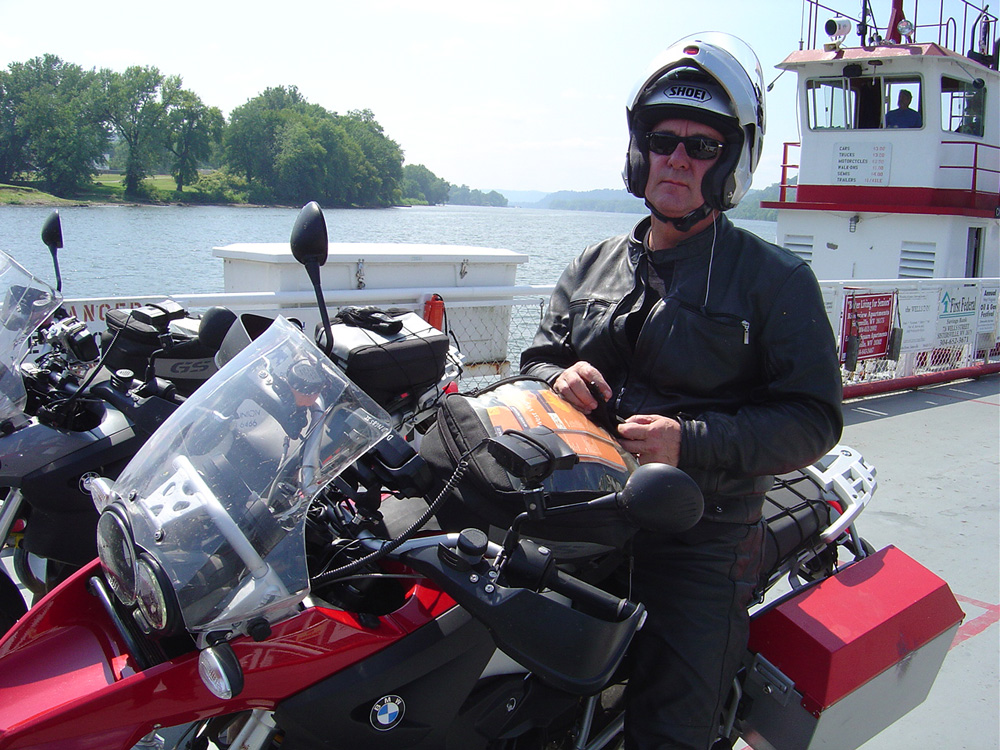 |
From Fly, Ohio, to Sistersville, West Virginia |
This third run of the Snakes and Arrows tour mainly covered the Midwest, Ontario, and Quebec, and as I scrutinized the relevant maps each day, I looked closely where we had to cross a major river, seeking a ferry between the bridges. Michael and I ferried across the Wabash River from Illinois to Kentucky; across the Ohio from Kentucky to Indiana, and from Ohio to West Virginia; out in Lake Erie to Put-in Bay on the Bass Islands; across the Ottawa River from Ontario to Quebec, then back again a week later; and two separate ferries across the St. Lawrence River from New York State, through Wolfe Island, to Ontario.
The back roads of America are also full of history - I'll never forget a bronze plaque I saw on a brick wall in a small Ohio town, "At This Spot, on April 14, 1864, During the Civil War, Absolutely Nothing Happened."
Art and life were brought together once again when I was reading Stegner's The Gathering of Zion, and planning our route between Columbus and Chicago. I sent us all the way across Illinois, to a tiny dot on the map hard by the Mississippi called Nauvoo.
The community was established in the mid-nineteenth century by the followers of Joseph Smith, who eventually became known as the Church of Jesus Christ of Latter-Day Saints - the Mormons. Smith told his followers that Nauvoo meant "beautiful place" in Hebrew, and, as Stegner wryly notes, "without pausing to consult their Hebrew dictionaries," they set to work, with the cooperative qualities that would characterize their Utah home as "the Beehive State," building a thriving community there in just five years.
For complicated reasons, the saints always seemed to alienate and infuriate their non-Mormon neighbors wherever they settled, and the "Gentiles" around Nauvoo were determined to drive them out. A mob attacked and murdered Joseph Smith and his brother Hyrum in the jail at the county seat of Carthage, Illinois, and soon the remaining saints started west on the great trek of 1847, led by Brigham Young, that would carry them to the New Jerusalem, the Great Salt Lake.
That story is too vast even to summarize here, but I was sufficiently intrigued to lead Michael through several hundred miles of cornfields and soybeans to Carthage, where the saints have rebuilt the courthouse where the murders took place, and to Nauvoo, where the church has created a massive shrine to Mormon history, centered around a reconstruction of the original temple from 1864, which had been destroyed by vandals, fire, and tornados - acts of man and God. (Nothing so fires religious fervor as a little resistance, from man or God, as proof of the "testing" of their faith.)
When we played Salt Lake City this tour, I noticed a cheer from the audience when Geddy sang the line from "Digital Man," "He'd like to spend the night in Zion." The Mormons in the audience might have taken it as a reference to their promised land, or to the magnificent national park in southern Utah I wrote about in Ghost Rider, but I had actually drawn the reference from the Rastafarian theology. Bob Marley also associated Zion with good, and Babylon with evil - as in the live recording from an American tour, Babylon by Bus.
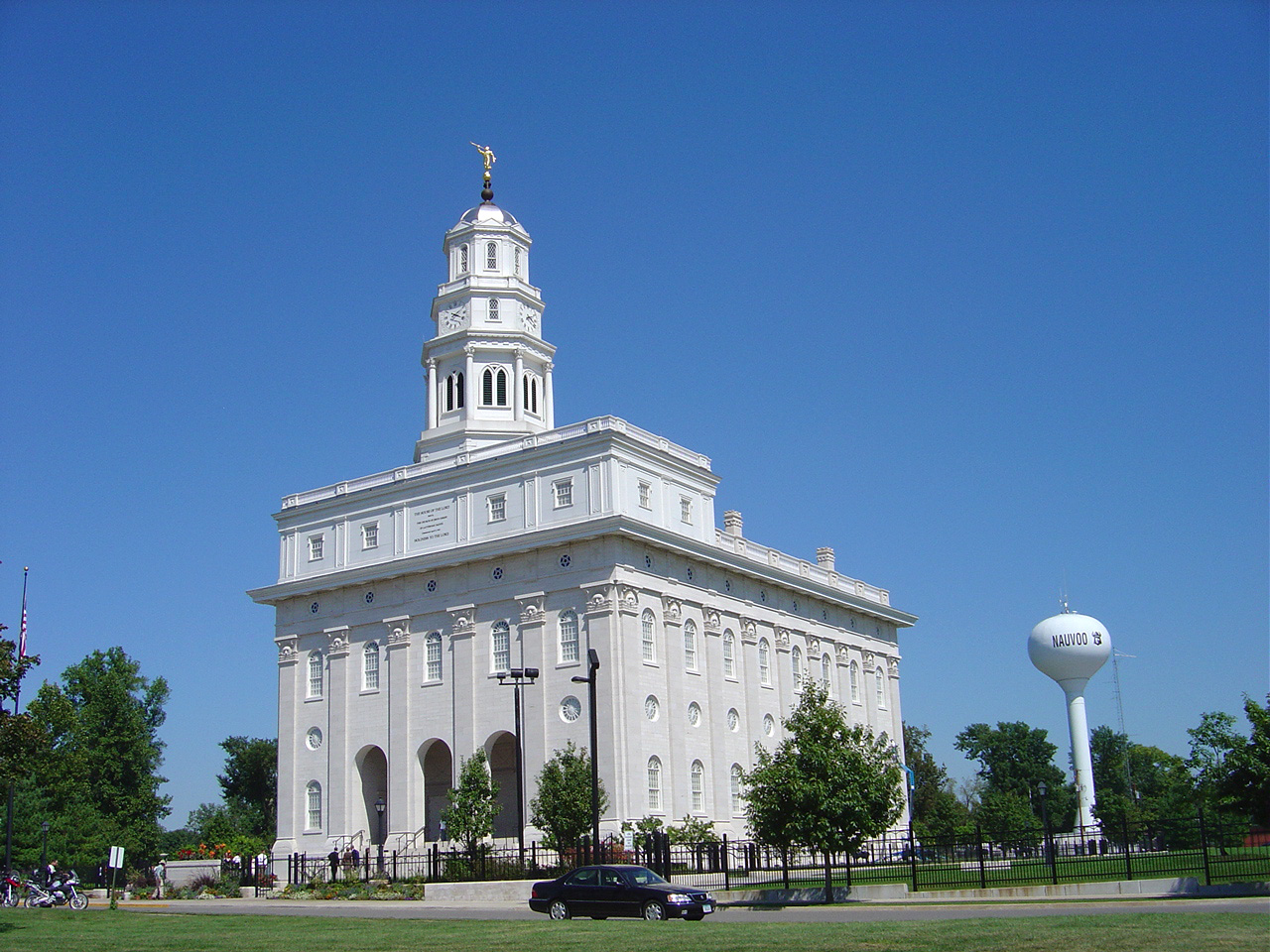
Note our motorcycles looking dwarfed in the left corner, and the water tower in the background, a study in contrasts. Here is a town of barely a thousand people that few "Gentiles" have even heard of, yet it attracts 300,000 visitors every year - chiefly Mormons, of course.
And shunpikers like us. We pulled up on our motorcycles and parked in front of the temple, and Michael said that while I was off taking pictures, the well-dressed people coming out of the temple were unusually smiling and friendly - no doubt figuring we must be Mormons, or why would we be there?
Well, because that's what we do - we explore strange new worlds and alien civilizations. (Michael actually made that comparison later that same day, at our motel in Burlington, Iowa, thinking back over some of the pockets of eccentric Americana we had been traveling through. He thought I would be Captain Kirk and he would be Spock, but I'm not sure about that.)
We do meet a lot of friendly people on those country roads, from the sheriff in North Carolina leaning back in a chair outside his office and waving as we passed, to the kids waving from the backs of school buses or Amish carriages, to the white-haired lady putting gas in her Buick at a crossroads gas station in central Illinois who called over to Michael and me, "I'll pay for yours if you'll pay for mine!"
That was a twist on our manager's old line about how my approach to touring was "a long motorcycle trip where you can earn a little gas money along the way." As our traveling circus of band and crew has continued to mount and perform our roadshow almost fifty times now, earning that gas money has continued to be a difficult, physically demanding job. As always seems to happen in the middle of every tour, when the routine grinds on into the third and fourth months, the mood at work among band and crew can sometimes sink to a tense, dark state of mind that combines homesickness, fatigue, edginess, frustration, friction, physical pain, and a feeling that threatens to approach "fed up."
Still, most of us "keep the shiny side up." Daily smiles and nightly jokes leaven the potential for tedium, and - most important - the band has continued to play to a high standard, supported by a first-rate, and highly entertaining crew (we entertain the crowd; they entertain us). The audiences have been fantastic everywhere, and the shows have been going well, but - like the gas that goes into our motorcycles - it just keeps costing more.
And as for buying gas, sometimes just finding it could be a challenge for us shunpikers - one day in Missouri we had to ride ten miles off our route just to find a gas station. Restaurants, too, could be scarce. In the dog days of August, we would often set off early in the cooler hours, planning to stop for breakfast later, only to ride for hours before we encountered a suitable "family restaurant."
But that was another admirable facet of shunpiking: the adventure of searching out restaurants and places to stay overnight. (Late one afternoon as Michael and I cruised the motel offerings of Newberry, Michigan, in the middle of a thousand-mile ride from St. Paul, Minnesota, to London, Ontario, Michael pointed out that while I was judging motels by their charm, he was judging them by whether they accepted American Express - for practical reasons, to keep his receipts in order.)
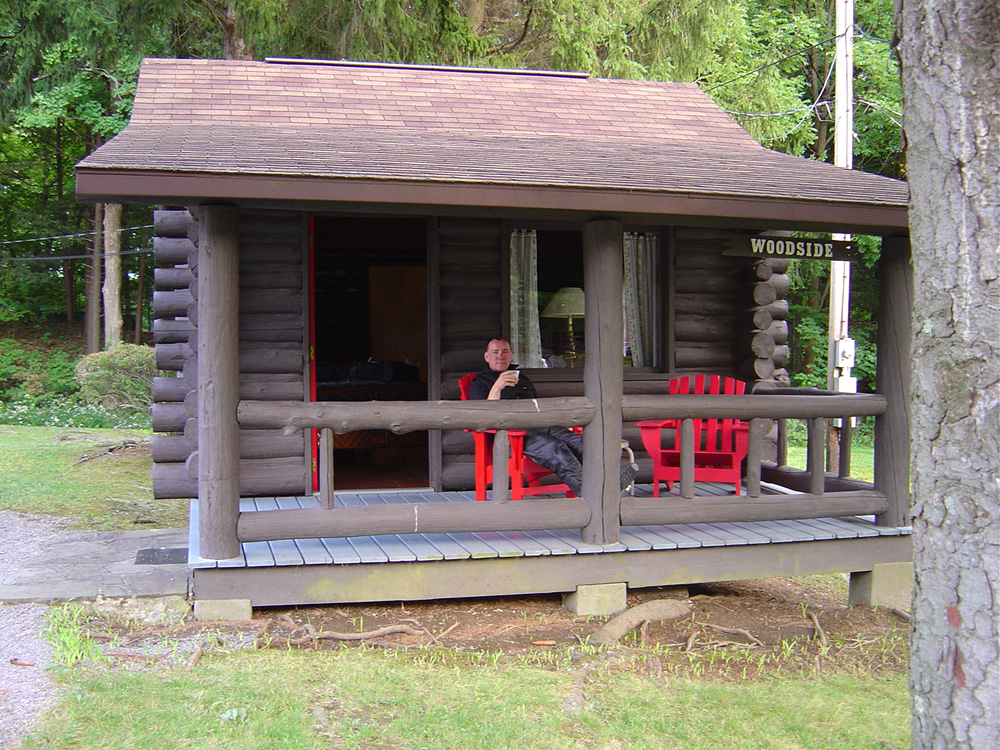
As a general thing, in the one-stoplight towns you won't find first-class luxury, but chances are you will find a clean room or cabin in a quiet, slowed-down world that offers open friendliness, a bag of ice for your end-of-day beverage, a plain and hearty meal, and maybe a little peace.
A moment's peace is a necessary way-point on our days off between shows, because while it's nice that I can commute to work by shunpiking from job to job on my motorcycle, it should be remembered that when I wake up on the bus and wheel that motorcycle out of the trailer, there's only one destination I really want to set my GPS for:
Home.
Quickest Way.